
Contents




Flowers at Suncheon Bay

Artistic Director of Dance Makes Modern Dance like Live Film

Quilting Squares of Tolerance

2018 Inter-Korean Summit




Meet the Dance of
Flowers at Suncheon Bay
May We Live Life in Full Bloom Like a Springtime Garden
It’s raining flowers at the Suncheon Bay National Garden.
The showers of falling petals set the hearts of picnickers aflutter.
The themed gardens are well worth a visit any time of the year, regardless of the season.
In spring, however, the fields of vibrant flowers are even harder to resist.
The Suncheon Bay National Garden, abuzz with the energy of spring, is a reminder to live your life in full-bloom.
Written by Kim Young-ihm, Editor Photographed by Studio Kenn
Illustrated by Hagogo

Suncheon Bay National Garden,
Coexistence between Humankind and Nature
The 2013 Suncheon Bay Garden Expo was a successful event that was highly praised by many. The Suncheon Bay National Garden has gained a reputation as an ecological venue representing harmony between humankind and nature. Home to a wide variety of flowers and plants, the vast garden is a space dedicated to the sustainable growth of nature. Frequently cited as a place to visit at least once in your lifetime, the Suncheon Bay National Garden is at its most beautiful in the spring. It's a paradise for those seeking to immerse themselves in the splendor of spring. There is no better place to enjoy a gentle breeze or to laze around in the sun. The garden is filled with more than a hundred million flowers, each offering its own unique scents and charms. Visit the Suncheon Bay National Garden to invigorate your senses and to rediscover the joy of the simple things in life.
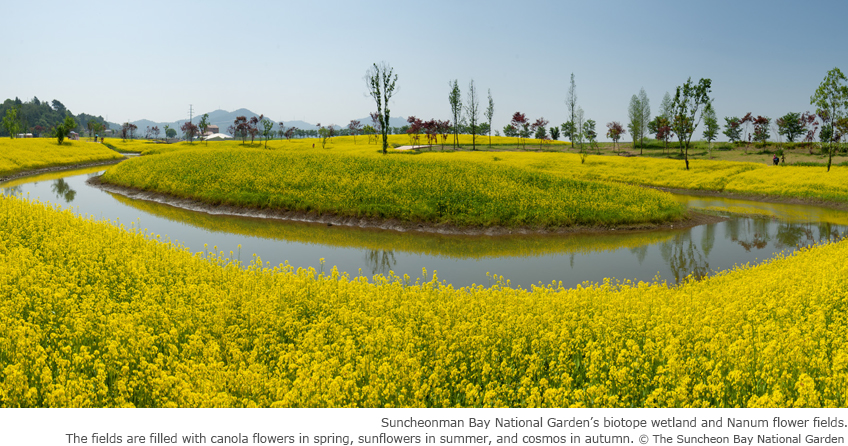
A Wealth of Walking Paths
for Garden Lovers
The Suncheon Bay National Garden offers a variety of walking trails from which to choose. One way of fully appreciate the whole garden is to choose a trail that matches your interests. The Hope of the Wetland trail, true to its name, is a place where you can see the magnificence of nature. It goes past the Suncheon Bay International Wetland Center, the Eco-Geo Greenhouse, the Suncheon Bay Ecological Park and the Hooded Crane Maze Garden. The Breath of Green Nature trail takes you around the world with its country gardens, including a Korean Garden, a Chinese Garden, a French Garden, a German Garden, a Thai Garden and a Japanese Garden. Engage in a deep conversation with nature along the World Landscape trail, which features a Dutch Garden, a U.S. Garden, a Spanish Garden, an Italian Garden and a British Garden. Lastly, the One With Nature trail offers interactive experiences at the Children’s Play Garden, the Rose Garden, along the Lugworm’s Path, in the Medicinal Herb Garden and along the Bridge of Dreams.
Participate in the show, learn more about the Suncheon Bay National Garden and write your own experiential learning report! Forms can be obtained at the East Gate Information Booth, the West Gate Information Booth and at the Ecotour Experience Learning Center. You can fill them out in either English or simplified Chinese. For a more memorable experience, head to the Pond Garden to have your portrait drawn with the beautiful landscape of the Suncheon Bay National Garden in the background.

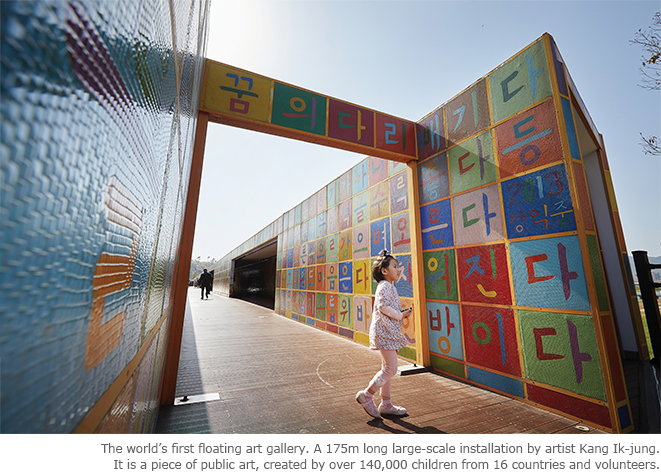
Suncheon Bay Wetland Reserve,
the Breath of the Ecosystem
After being declared a wetland preservation area in 2003, Suncheon Bay joined the Northeast Asian Crane Site network in 2004 and in 2006 became the first wetland in Korea to be designated as a Ramsar Site. Comprised of 5.4 square kilometers/ 2.1 square miles of reed beds and 22.6 square kilometers/ 8.5 square miles of mudflats, the Suncheon Bay Wetland Reserve is one of the world’s top-five coastal wetlands. It is a spotting ground for rare birds, sand crabs, ghost crabs and mudskippers. Visitors can gain a more in-depth understanding of the site at the Suncheon Bay Eco-Museum, at the Suncheon Bay Observatory and at the Sounds of Nature Experience Center.
The Suncheon Bay Literature Hall celebrates the literary legacy of writers with ties to the Suncheon area, such as Kim Seungok (b. 1941) (김승옥) and Jeong Chae-bong (b. 1946) (정채봉).
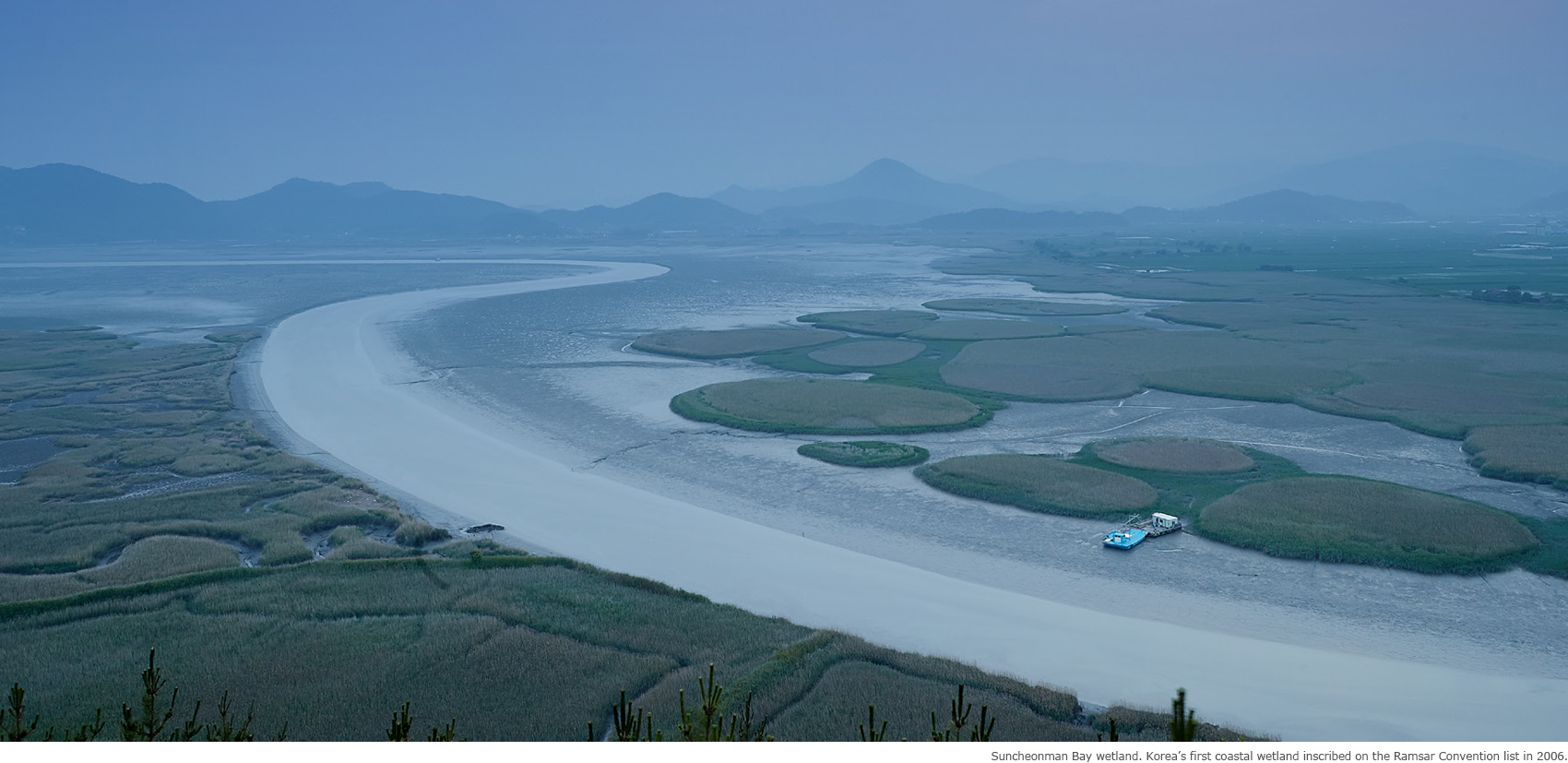
-
Naganeupseong, where even time comes to a stop
- Designated as Historic Site No. 302, the Naganeunseong Folk Village is a small, humble village that takes you back in time. Enjoy a break from the fast pace of life and follow the traces of history etched into the low stone walls and the straw-thatched roofs.
Every detail is infused with the warmth of the vil lagers and a sense of nostalgia. The village is home to well-preserved historical sites, such as the magistrate’s office, a dolmen park, a monument to General Im Gyeong-Eop (1594-1646) (임경업, 林慶業), the Nangminnu Pavilion, a former prison and a lotus pond. Its leisurely ambience will help to keep your mind off your troubles and to take things in stride.
- Designated as Historic Site No. 302, the Naganeunseong Folk Village is a small, humble village that takes you back in time. Enjoy a break from the fast pace of life and follow the traces of history etched into the low stone walls and the straw-thatched roofs.
-
The 1,000-year heritage of Seonamsa Temple
(선암사, 仙巖寺)- Before entering the temple, you will cross a beautiful arched stone bridge called the Seungseon-gyo Bridge (승선교, 昇仙橋). Designated as National Treasure No. 400, the bridge is one of the few rainbow-shaped bridges in Korea, along with the Bihong Bridge at the entrance to Jangansa Temple.
Seonamsa Temple is a reconstruction of the Biroam Hermitage founded by monk Ado (아도, 阿道) in the seventh year of the reign of King Seong of Baekje (A.D. 529). Then in the first year of the reign of King Gyeongmun of Silla (A.D. 861), Zen master Doseon (도선, 道詵) (A.D. 827-898) built a much larger temple here. Among the temple’s highlights are its collection of Buddhist paintings, the oval-shaped Samindang Pond and the majestic Daeungjeon Hall.
- Before entering the temple, you will cross a beautiful arched stone bridge called the Seungseon-gyo Bridge (승선교, 昇仙橋). Designated as National Treasure No. 400, the bridge is one of the few rainbow-shaped bridges in Korea, along with the Bihong Bridge at the entrance to Jangansa Temple.
-
Travel back in time at the Suncheon Open Film Location
- The Suncheon Open Film Location is an attraction not to be missed if you want to travel back in time some 50 years. The film set is a realistic recreation of small Korean towns and villages from the 1960s and 1970s. Try on a traditional school uniform and imagine yourself in a TV soap opera. You'll be able to reflect on our history and develop a better appreciation of modern conveniences.
Trip Points

Tulips Dressed in Waves of Vivid Colors
Every spring, the Dutch Garden comes alive with its colorful beds of tulips. The lovely flowers are a favorite of children, making them run about the garden in delight. The glorious flowering bulbs are a perfect match with the playful, delicate vibe of spring. As the tulips in the Netherland’s Garden are the first to bloom and fall in the Suncheon Bay National Garden, the crowd is at its peak at the time of the tulip’s coming into bloom. Seen with eyes, their colors are too beautiful to be believed as the creature of nature. There are some visitors who touch the petal, suspicious if it is artificial. But please enjoy flowers with your eyes only.

Splash of Yellow in Canola Flower Fields
The seemingly endless fields of canola flowers are the crown jewel of the Suncheon Bay National Garden. Their ecological value is enhanced as the area is classified as a wetland biotope. Take a leisurely stroll in the garden to soak up the dazzling yellow of canola flowers and to immerse yourself in the sunny warmth of spring. Is it because of the bright energy of the yellow wave? When you stop walking to press the shutter toward the canola flowers, there comes laughing sound everywhere. Let’s fall in love with the yellow canola flowers before spring goes away.
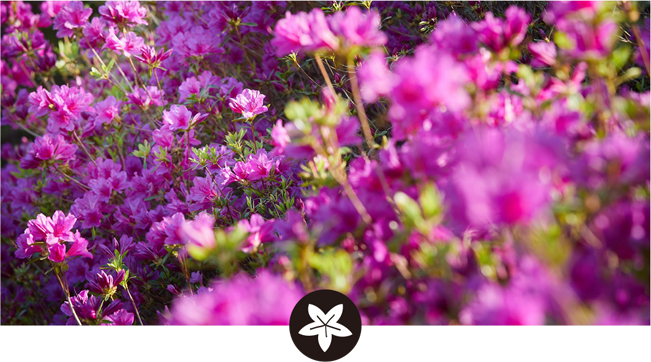
Celebrating Spring with Azaleas and Peonies
On the west side of the Suncheon Bay National Garden, azaleas and peonies scramble to announce that spring is in full swing. After the azaleas flaunt their beauty and fiery red hues, the peonies take their turn to impress visitors with their distinctive shades of white. As you walk between the rows of beautiful flowers, you will be blown away by the explosion of colors and rich fragrances. The heavenly garden of azaleas and peonies will empower you with a sense of hope and vitality.
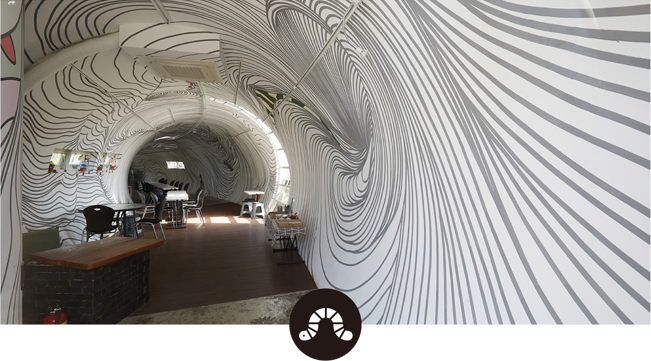
Engage Your Five Senses and Enjoy Suncheon Bay
The Lugworm Library, designed after the trail left by a lugworm, features a gallery, a library, a lounge and a café. You can enjoy exhibitions and read books in cozy spaces overlooking the beautiful garden. Recently, the library acquired rare sketches and writings by Charles Jencks (b. 1939), the architect of the Suncheon Lake Garden, by Kang Ik-joong (b. 1960) (강익중), the artist behind the “Bridge of Dream” (2013) in Suncheon, and by Hwang Ji-hae (황지혜), the designer who made the “Lugworm’s Path.” The library’s horticulture class teaches how to make wooden necklaces, wooden tongs and fancy flower bracelets. Fans of the TV variety show “Running Man” (런닝맨) may recognize it from one episode.

Travel Tip
-
Suncheon Bay National Garden
- Address: 47, Gukgajeongwon1ho-gil, Suncheon-si, Jeollanam-do
- Inquiries: +82-1577-2013
- Website: http://garden.sc.go.kr
- vailable in English, Japanese, simplified Chinese, Russian, Vietnamese, Thai and Malaysian/ Indonesian
-
Suncheon Bay Wetland Reserve
- Address: 513-25, Suncheonman-gil, Suncheon-si, Jeollanam-do
- Inquiries: +82-61-749-6052
- Website: http://www.suncheonbay.go.kr
- Available in English, Japanese and simplified Chinese
-
Opening hours
Suncheon Bay National Garden
- March or April until October : 8:30 a.m. to 7 p.m.
May to September : 8:30 a.m. to 8 p.m.
January or February until November or December : 8:30 a.m. to 6 p.m.
*Ticket sales end one hour prior to closing.
Suncheon Bay Wetland Reserve
- 8 a.m. until sunset
*Ticket sales end between 5 and 7 p.m., depending on the season.
- March or April until October : 8:30 a.m. to 7 p.m.
Other Articles




Flowers at Suncheon Bay

Artistic Director of Dance Makes Modern Dance like Live Film

Quilting Squares of Tolerance

2018 Inter-Korean Summit



Application of subscription
Sign upReaders’ Comments
GoThe event winners
Go


 May 2018
May 2018


